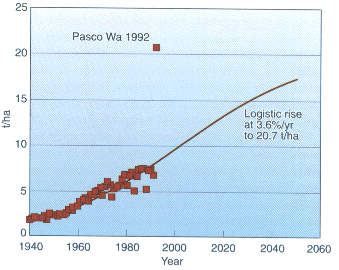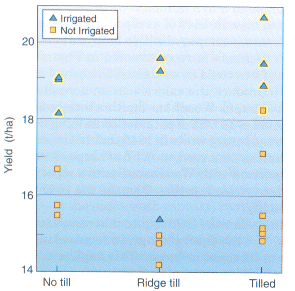A course of changing yields illustrated by Figure 7.2.1 rather than a yardstick of events customarily begins an analysis of agricultural progress and how it may continue. I now follow that custom. Figure 7.2.1 depicts the rising yield per plot of three crops in the United States. Although the figure shows the outcome for only three crops and one nation, global data confirm that yields of many crops and nations followed a similar course during the twentieth century.
During the 1970s and 1980s, population rose 1.7%
per year. Nevertheless, farmers improved the average
per capita diet of both calories and protein about
0.5%/yr. To improve the per capita diet, farmers did
expand arable and permanent crops 0.2%/yr. Nevertheless,
in global terms and annually, farmers fed
1.7% more people 0.5% more energy and protein while
shrinking the amount of land farmed per person by
fully 1.5%![]()
Pessimists and optimists see different clues in the rise of yields since 1940. Pessimists search for hints that the rise will level off. Pessimists will worry whether national averages can approach yields on experimental or prize-winning plots. They will reason that yields far above primitive ones mean more effort must go into maintenance (Plucknett and Smith, 1986[PS86]) and see that averages have recently fallen farther below the trend than during 1940-1970.
Optimists will see clues that humanity will continue to sidestep the Malthusian apocalypse while sparing more land for Nature. Optimists will trust that new techniques can raise the ceiling on yields and that a relay race of maintenance research and application can steady the annual averages.
Optimists and pessimists can agree on some things. About maintaining higher and higher yields, both would agree with a philosopher:
For certainly progress in civilization has not only meant increase in the scope and intricacy of problems to be dealt with, but it entails instability. For in multiplying wants, instruments and possibilities, it increases the variety of forces which enter into relations with one another and which have to be intelligently directed .... Since all objective achievement only complicates the situation, the victory of a final stability can be secured only by renunciation of desire. Since every satisfaction of desire increases force, and this in turn creates new desires, withdrawal into an inner passionless state, indifference to ad ion and attainment, is the sole road to possession of the eternal, stable and final reality (Dewey, 1922[Dew22]).
Neither optimists nor pessimists would be surprised
that much, perhaps most, research must be
devoted to maintaining the gain in yield already
attained.![]()
Both would agree that using the record from 1940 to today to foresee the next half century is only an extrapolation. They would agree that only unremitting work by scientists, sensible incentives, and smart farmers will sustain the rising trend. And the optimists would admit to the pessimists that nothing goes up forever. Everyone agrees that rising yields eventually must strike such a limit as the supply of solar energy or water.
The simplest summary of N rising at a proportional
rate r toward a limit K is the logistic equation![]()
![]()
The proportional rate r raising N exponentially can
be called the Malthusian parameter. It seems most
fitting for a population multiplying in proportion to
its numbers, N. If technology makes more technology
easier to find and also encourages farmers to adopt
it, a proportional rate r also can be conceived for the
rising yields after 1940.
But for yields, where is the limit K? Because only equivocal hints of a limit can be seen in such graphs as Figure 7.2.1, searching for a limit by fiddling and fitting the logistic equation still will end with an equivocal estimate of K. Instead, I shall substitute concrete measurements for the limit in the logistic equation and see how it fits such courses as Figure 7.2.1.
In the preceding section, I examined physical limits like sun for photosynthesis and water for turgor. Solar energy plus measurements of photosynthesis in the laboratory set limits of 45 t/ha of biomass at 400 and of 30 t/ha at 500 latitude. These would correspond to about 22 and 15 t/ha grain. Because several species of plant actually grew as fast as 200 kg/ha/day, the limit of 22 t/ha at 500 North seemed a reasonable upper limit for the accumulation of biomass during a season. Or at least deWit and Alberda concluded so one-quarter century ago.
The winner of a contest with a productive crop also
can set the limit, at least for the time being. Maize,
with its efficient C4 photosynthesis, is surely a productive
crop. In 1992, the National (U.S.) Corn Growers
Association competition enrolled 2,470 entries
from 44 states. To qualify for the contest, farmers had
to enter a minimum of 4 ha of maize and to keep the
accurate production and harvest records required by
rules. The winning, irrigated field in Pasco, Washington
(![]() North and sunny climate) grew fully 21 t
grain/ha! Other yields above 18 t/ha prove that the
21 was not a fluke (Figure 7.3.1) (National Corn
Growers Association, 1993[Ass93b]).
North and sunny climate) grew fully 21 t
grain/ha! Other yields above 18 t/ha prove that the
21 was not a fluke (Figure 7.3.1) (National Corn
Growers Association, 1993[Ass93b]).
 Figure 7.3.1. The three highest yields of maize in irrigation and
tillage classes of the National (U.S.) Corn Growers
Association competition in 1992. Although the
excess is less than in regional averages, irrigated
exceed rain-fed yields even among the winners
among 2,470 entries from 44 states (National Corn
Growers Association, 1993). [Ass93b]
Figure 7.3.1. The three highest yields of maize in irrigation and
tillage classes of the National (U.S.) Corn Growers
Association competition in 1992. Although the
excess is less than in regional averages, irrigated
exceed rain-fed yields even among the winners
among 2,470 entries from 44 states (National Corn
Growers Association, 1993). [Ass93b]
Twenty-one tons stands incredibly near deWit's
limit of 22. Of course, one-quarter century of breeding
of a C4 plant and enrichment of the air with ![]() since deWit's calculation plus irrigation and 1992
husbandry lie behind the 21 t. In the mid-nineteenth
century, a farmer reasonably might have speculated
that the limit on maize yield was greater than 5 t/ha,
which was then about three times the national
average. Near the end of the twentieth century we
reasonably could speculate that the limit exceeds 21
t/ha, which is three times our present national average.
Because 21 t/ha actually has been produced,
however, I shall take K to be 21 in the logistic equation.
since deWit's calculation plus irrigation and 1992
husbandry lie behind the 21 t. In the mid-nineteenth
century, a farmer reasonably might have speculated
that the limit on maize yield was greater than 5 t/ha,
which was then about three times the national
average. Near the end of the twentieth century we
reasonably could speculate that the limit exceeds 21
t/ha, which is three times our present national average.
Because 21 t/ha actually has been produced,
however, I shall take K to be 21 in the logistic equation.
 Figure 7.3.2 The logistic rise of the national average of maize
yields toward a maximum of 21 t/ha (National Corn
Growers Association, 1993; U.S. Department of
Agriculture, various years).[Ass93b][USDa]
Figure 7.3.2 The logistic rise of the national average of maize
yields toward a maximum of 21 t/ha (National Corn
Growers Association, 1993; U.S. Department of
Agriculture, various years).[Ass93b][USDa]
I compare in Figure 7.3.2 the rise of the national average yield of maize since 1940 with a logistic rise of 3.6%/yr toward the limit of 21 t/ha. I extended the time to the middle of the twenty-first century, more or less when population will reach ten billion. Comparison of the national averages with the logistic curve is reassuring. Although the averages have varied--as during the 1988 drought, they generally follow the curve. And, of course, they have a long way to go before striking the limit of the yield on the 4 ha that won the 1992 contest.
Section 6.1 concluded that sun, warm days, and land to stand on will not soon limit food supply. The present section can conclude that the ceiling on what a smart farmer can raise per plot stands well above present averages because real crops and husbandry existing today have yielded fully 21 t/ha.